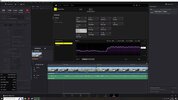Nigel
Well-Known Member
- Joined
- Jul 7, 2014
- Messages
- 17,311
- Reaction score
- 9,061
- Location
- Wales
- Country
- United Kingdom
- Dash Cam
- Gitup F1+G3ꞈꞈꞈꞈꞈ Viofo A229ꞈꞈꞈꞈꞈ Blueskysea B4K
That is A V One, not A V I 
@Panzer Platform asked for some raw AV1 footage from a dashcam, which is currently impossible since currently there are no dashcams that support AV1, so I've converted some 60Mb/s dashcam video from a Viofo A139 Pro into AV1 @ 17Mb/s and uploaded to Youtube and Google Drive:
 drive.google.com
drive.google.com
So why don't dashcams currently support AV1? I think it is because current SoC chips don't have the capability of encoding good quality 4K video into AV1 format in real time, it takes a lot more work than encoding H264, and a fair amount more than H265. However AV1 is already available in Video Conferencing equipment, and it seems likely that AV1 in dashcam SoCs is probably not far away.
What are the advantages of AV1 for dashcams?
1. The main advantage of AV1 is that it has better compression, so you can either have better quality, or longer recording times on your memory card, however I'm not convinced that this is the most important advantage for dashcams, you could just use a bigger memory card!
2. If a recording is interrupted mid recording, maybe through power loss, the recording does not become corrupt, so there is no real need for a battery or capacitor in the dashcam. Since batteries/capacitors are the biggest and most unreliable components in dashcams, dashcams can become smaller and more reliable.
3. Better compression for dashcam use. AV1 appears to keep license plate details even at high compression ratios, where plate details would get lost in H264 and H265. Also, it does not produce blocky skies and road surfaces like H264/H265 do. So overall it just looks better at higher compression ratios. Presumably it is still loosing some details, just not the important details!
4. It is a free codec, so there are no licensing issues, nobody is going to prosecute me for uploading the AV1 file above, which with an H265 file may actually be possible, even if unlikely. It may also reduce camera cost by not needing to pay for licenses, although I would expect that an SoC chip with an AV1 encoder in is going to be extra cost for a while.
5. Compatibility? H265 causes problems on some playback devices and is not available in all video software, I think mainly because it is not always installed as standard because of the licensing issues. AV1 has no licensing issues so can be installed as standard on everything, except it is fairly new, so is not installed on older devices.
6. HDR and 10 bit colour resolution are standard features, supported by all AV1 compatible devices.
Disadvantages?
1. It takes days to encode an AV1 file, unless you have a device with a hardware AV1 encoder built in!
2. AV1 files have HDR as standard, but having uploaded one to Youtube, it then takes Youtube days to process the HDR ... check back in a day or two to see the HDR logo appear on the above Youtube upload!
@Panzer Platform asked for some raw AV1 footage from a dashcam, which is currently impossible since currently there are no dashcams that support AV1, so I've converted some 60Mb/s dashcam video from a Viofo A139 Pro into AV1 @ 17Mb/s and uploaded to Youtube and Google Drive:
Aberystwyth_AV1_6.mkv
 drive.google.com
drive.google.com
So why don't dashcams currently support AV1? I think it is because current SoC chips don't have the capability of encoding good quality 4K video into AV1 format in real time, it takes a lot more work than encoding H264, and a fair amount more than H265. However AV1 is already available in Video Conferencing equipment, and it seems likely that AV1 in dashcam SoCs is probably not far away.
What are the advantages of AV1 for dashcams?
1. The main advantage of AV1 is that it has better compression, so you can either have better quality, or longer recording times on your memory card, however I'm not convinced that this is the most important advantage for dashcams, you could just use a bigger memory card!
2. If a recording is interrupted mid recording, maybe through power loss, the recording does not become corrupt, so there is no real need for a battery or capacitor in the dashcam. Since batteries/capacitors are the biggest and most unreliable components in dashcams, dashcams can become smaller and more reliable.
3. Better compression for dashcam use. AV1 appears to keep license plate details even at high compression ratios, where plate details would get lost in H264 and H265. Also, it does not produce blocky skies and road surfaces like H264/H265 do. So overall it just looks better at higher compression ratios. Presumably it is still loosing some details, just not the important details!
4. It is a free codec, so there are no licensing issues, nobody is going to prosecute me for uploading the AV1 file above, which with an H265 file may actually be possible, even if unlikely. It may also reduce camera cost by not needing to pay for licenses, although I would expect that an SoC chip with an AV1 encoder in is going to be extra cost for a while.
5. Compatibility? H265 causes problems on some playback devices and is not available in all video software, I think mainly because it is not always installed as standard because of the licensing issues. AV1 has no licensing issues so can be installed as standard on everything, except it is fairly new, so is not installed on older devices.
6. HDR and 10 bit colour resolution are standard features, supported by all AV1 compatible devices.
Disadvantages?
1. It takes days to encode an AV1 file, unless you have a device with a hardware AV1 encoder built in!
2. AV1 files have HDR as standard, but having uploaded one to Youtube, it then takes Youtube days to process the HDR ... check back in a day or two to see the HDR logo appear on the above Youtube upload!



